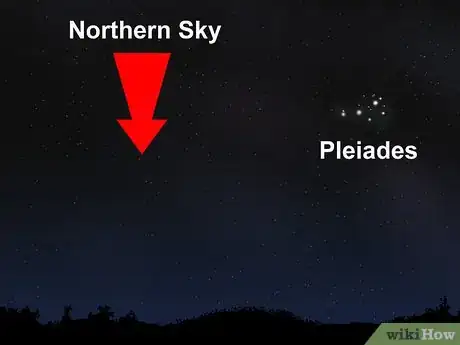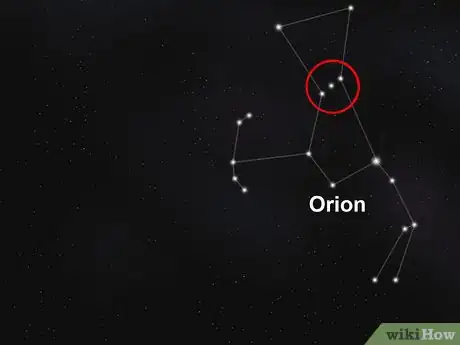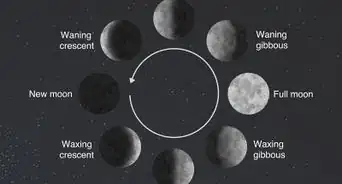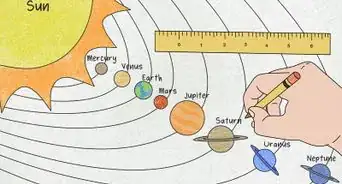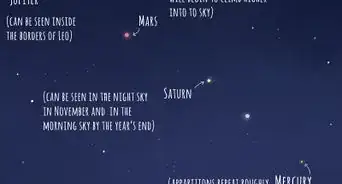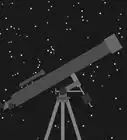This article was co-authored by wikiHow Staff. Our trained team of editors and researchers validate articles for accuracy and comprehensiveness. wikiHow's Content Management Team carefully monitors the work from our editorial staff to ensure that each article is backed by trusted research and meets our high quality standards.
There are 13 references cited in this article, which can be found at the bottom of the page.
wikiHow marks an article as reader-approved once it receives enough positive feedback. This article received 12 testimonials and 91% of readers who voted found it helpful, earning it our reader-approved status.
This article has been viewed 280,510 times.
Learn more...
The Pleiades or Seven Sisters form a beautiful star cluster near the constellation Taurus. This is one of the nearest star clusters to Earth and perhaps the most beautiful to the naked eye. Over the millennia it has inspired folklore around the world, and is now studied as a recent birthplace for new stars.
Steps
From the Northern Hemisphere
-
1Look for the Pleiades in autumn and winter. In the Northern Hemisphere, the Pleiades star cluster becomes visible to evening observers in October and disappears in April. November is the best time to look for the Pleiades, when they are visible from dusk to dawn and reach their highest point in the sky.[1]
- In early October, the Pleiades become visible a couple hours after sunset. By about February, the Pleiades are already high in the sky at sunset.[2] (The exact timing depends on your latitude.)
- The Pleiades are visible in late summer and early autumn as well, but only in the middle of the night.
-
2Face the southern sky. The Pleiades rise in the southeast after dusk and travel west during the night. During their peak in November, they climb high in the sky and disappear in the northwest before dawn. In late winter and early spring, they will only be visible for a few hours, traveling east to west across the southern part of the sky.[3]Advertisement
-
3Find Orion. Orion the Hunter is one of the most famous and distinct constellations in the sky. On a winter evening at a mid-northern latitude, he stands almost due south, about halfway between the horizon and the sky directly above your head.[4] Locate him by his belt, a straight line of three bright stars close together. The red star nearby, Betelgeuse, forms his left shoulder (from your perspective), while the blue giant Rigel on the other side of the belt is his right leg.[5]
-
4Follow the line of the belt to Aldebaran. Treat Orion's belt as an arrow pointing to your next landmark, moving from left to right in the sky. (At most times and places, this will point to the northwest.) The next bright star you see in this direction is another bright, red-orange star: Aldebaran. This is the Arabic word for "Follower," likely named because it chases the Pleiades each night.[6]
- Aldebaran is not in a perfect line with the belt. Don't try to get there with binoculars, or you may miss it.
- Aldebaran dips below the horizon around March, or earlier in extreme northern latitudes.[7] If Aldebaran isn't visible, try to follow Orion's belt all the way to Pleiades.
-
5Move onward to find the Pleiades. Continue moving your eyes in the same direction (usually northwest), from Orion's belt to Aldebaran and beyond. Fairly near to Aldebaran, you should see a tight cluster of blue stars. These are the Pleiades, also called the Seven Sisters or M45.[8]
- Most people can only see six stars with the naked eye, or even just a hazy clump if light pollution interferes.[9] With a clear night and keen, dark-adjusted eyes, you may see more than seven.
- The Seven Sisters are clustered close together. From end to end the cluster is only ⅔ the width of Orion's Belt.[10] This is much less than the length of the Big Dipper or Little Dipper, star patterns which some novice stargazers confuse with this one.
-
6Use Taurus as a guide next time. The red star Aldebaran, described above, is also the eye of the constellation Taurus, the Bull. The Hyades star cluster nearby forms the chin of the bull. If you become familiar with this constellation, you can find it as a starting point and look for the Pleiades nearby.[11]
- Taurus may be difficult to see during a bright moon, especially near an urban area.[12]
From the Southern Hemisphere
-
1Watch for the Pleiades in spring and summer. The Pleiades are visible from about October to April, during the Southern Hemisphere's spring and summer months.[13]
-
2Face the northern sky. During late November, the Pleiades rise in the northeast around dusk and travel west until dawn. As the seasons progress, the Pleiades start higher in the sky when the stars appear, and spend less time in the sky.[14]
-
3Look for a line of bright stars. Orion is standing on his head in the Southern Hemisphere, so some observers call this constellation a sauce pan instead, with Orion's sword the handle pointing upward.[15] The rim of the saucepan (or Orion's belt) is a trio of bright stars in a straight line. This distinct shape is a starting point for locating many constellations.
- This line has the bright red star Betelgeuse on one side, and the bright blue star Rigel on the other.
-
4Follow the line left in the sky to Aldebaran. Use the line as an arrow pointing left across the sky. The next bright star in this direction is Aldebaran, a bright red supergiant. This is the eye of the constellation Taurus the Bull. If the sky is clear and the moon is dim, you can see the chin of the bull right next to Aldebaran, formed by the Hyades star cluster.[16]
-
5Continue on to the Pleiades. Keep following the same line from Orion's belt, and you'll run into a fairly dim cluster of blue stars. These are the Pleiades, also called the Seven Sisters — although most people can only see six or fewer, and telescopes can see many more. The Pleiades are an "asterism," a star pattern much smaller than a constellation. If you hold your thumb out at arm's length, the cluster is only about twice the width of your thumbnail.[17]
Community Q&A
-
QuestionAre the stars in Pleiades moving together? If so, why?
 TomPNTop AnswererYes, they are moving together. It's because the Pleiades is a star cluster - a group of stars that all formed out of the same nebula. Since they formed out of the same nebula, they are very close together, so gravity keeps them from flying off on their own paths.
TomPNTop AnswererYes, they are moving together. It's because the Pleiades is a star cluster - a group of stars that all formed out of the same nebula. Since they formed out of the same nebula, they are very close together, so gravity keeps them from flying off on their own paths. -
QuestionWill the Eagle nebula produce a star cluster in the far future?
 TomPNTop AnswererIt already has done do. The "Eagle nebula" is actually two parts. Messier 16 refers to the star cluster, whereas the nebula is called IC 4703.
TomPNTop AnswererIt already has done do. The "Eagle nebula" is actually two parts. Messier 16 refers to the star cluster, whereas the nebula is called IC 4703. -
QuestionWould one of the Pleiades be also called "Morning Star" in Navajo folklore? And which one?
 Community AnswerNo. Venus is what is known as the "Morning Star." That is because it can be seen during some parts of the year in the morning, after the sun starts to rise and all the other stars in the sky have disappeared. It is also sometimes called the "Evening Star" and the "Day Star."
Community AnswerNo. Venus is what is known as the "Morning Star." That is because it can be seen during some parts of the year in the morning, after the sun starts to rise and all the other stars in the sky have disappeared. It is also sometimes called the "Evening Star" and the "Day Star."
Things You'll Need
- Clear sky
- Binoculars (optional)
References
- ↑ http://earthsky.org/favorite-star-patterns/pleiades-star-cluster-enjoys-worldwide-renown
- ↑ https://evols.library.manoa.hawaii.edu/bitstream/10524/105/2/JL27179.pdf
- ↑ http://earthsky.org/tonight/november-is-the-month-of-the-pleiades
- ↑ https://books.google.com/books?id=BaMBgoKPmjAC
- ↑ https://www.space.com/pleiades.html
- ↑ https://www.space.com/pleiades.html
- ↑ http://www.windows2universe.org/the_universe/Aldebaran.html
- ↑ https://www.naic.edu/~gibson/pleiades/mag/xephem_all_labels.gif
- ↑ http://earthsky.org/tonight/moon-and-pleiades-or-seven-sisters
- ↑ http://www.pleiade.org/pleiades_03.html
- ↑ http://www.space.com/10710-orion-taurus-star-cluster-skywatching-tips.html
- ↑ http://earthsky.org/tonight/moon-and-pleiades-or-seven-sisters
- ↑ https://earthsky.org/favorite-star-patterns/pleiades-star-cluster-enjoys-worldwide-renown/
- ↑ https://earthsky.org/favorite-star-patterns/pleiades-star-cluster-enjoys-worldwide-renown/
- ↑ https://earthsky.org/favorite-star-patterns/pleiades-star-cluster-enjoys-worldwide-renown/
- ↑ https://earthsky.org/favorite-star-patterns/pleiades-star-cluster-enjoys-worldwide-renown/
- ↑ http://www.astronomynotes.com/nakedeye/s3.htm
- ↑ https://evols.library.manoa.hawaii.edu/bitstream/10524/105/2/JL27179.pdf
- ↑ https://books.google.com/books?id=3GbYg26S8pUC
About This Article
To find the Pleiades star cluster in the Northern Hemisphere, start by looking in the night sky from October to April, facing South. Next, locate the Orion constellation, which will be about halfway between the horizon and a spot directly above your head. Then, follow the line of Orion’s belt past a bright red-orange star called Aldebaran to a cluster of blue stars, which is Pleiades. If you’re in the Southern hemisphere, look for Pleiades in the Northern sky, and keep in mind that the Orion constellation will be upside down, or standing on its head. For tips on the best time of night to see find these constellations, read on.







